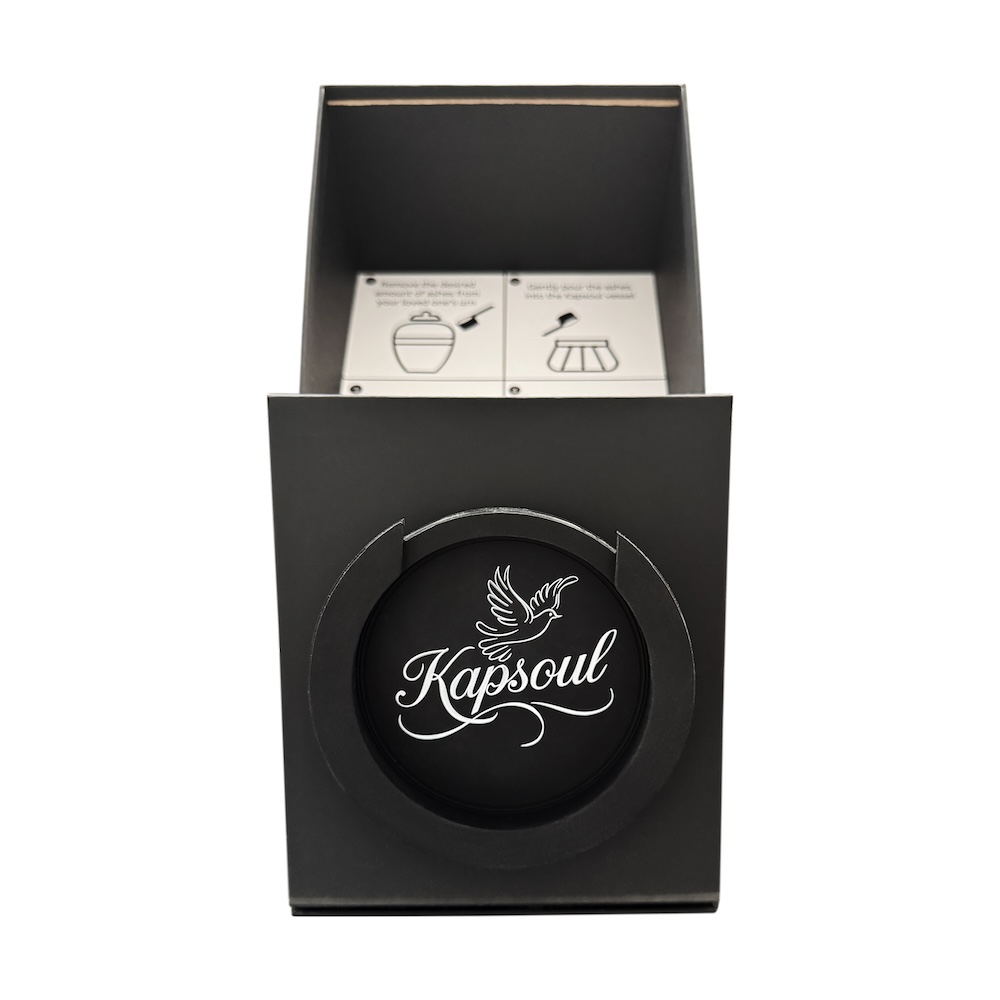Music tells stories that words alone cannot capture. Every chord progression carries emotion, every melody holds memory, and every rhythm beats with the pulse of human experience. As a guitar teacher who’s spent decades helping students find their voice through six strings, I’ve learned that our instruments become more than tools for making music—they become vessels for sharing the deepest parts of ourselves and those we love, much like how cremation urns hold the memories and essence of our loved ones.
When we lose someone precious to us, their story doesn’t end with their passing. It continues through the lives they touched, the memories they created, and the love they shared. For musicians dealing with grief, the guitar offers a unique opportunity to keep these stories alive, transforming loss into living tribute. With KapSoul’s innovative memorial integration, this storytelling takes on profound new dimensions that honor both musical tradition and enduring love.
The Power of Musical Storytelling
Music has served as humanity’s primary storytelling medium for thousands of years. Before written language, ancient cultures preserved their histories through songs passed down through generations. The guitar, with its melodic capabilities and harmonic richness, continues this tradition in our modern world.
When we play guitar, we’re not just creating sound—we’re crafting narratives. A gentle fingerpicking pattern might tell the story of quiet strength, while powerful strumming could represent passion and determination. These musical elements become the vocabulary we use to share the essence of those we’ve lost.
Research from the American Music Therapy Association shows that musical storytelling activates multiple brain regions simultaneously, creating more vivid and lasting memories than verbal narratives alone. When we share our loved one’s story through music, we’re creating multi-dimensional portraits that capture not just facts, but feelings.
KapSoul: A Revolutionary Approach to Musical Memorial

KapSoul represents a groundbreaking innovation in memorial storytelling through music. This specially designed soundhole cover fits acoustic guitars with standard 4-inch diameter sound holes and securely contains up to 8 ounces of a loved one’s ashes within its PPH (Polypropylene Homopolymer) interior lining.
What makes KapSoul extraordinary for storytelling is its transformation of the guitar from a storytelling tool into a storytelling partner. When your loved one’s physical presence becomes part of your instrument, every musical story becomes a collaboration. Their essence participates in each note, each silence, each emotional expression that flows through your guitar.
The included scooper facilitates respectful placement of ashes, acknowledging that this process creates more than a memorial—it creates a storytelling partnership that will last for years to come. Students who’ve integrated KapSoul describe their musical expression becoming richer, more meaningful, and somehow more complete.
Crafting Musical Narratives About Your Loved One
Creating musical stories about departed loved ones requires both technical skill and emotional courage. Start by identifying the key themes of their life story. Were they adventurous? Gentle? Funny? Resilient? These personality traits become the emotional foundation for your musical narratives.
Consider their favorite songs and musical preferences. If they loved jazz, incorporate extended chords and complex harmonies into your storytelling. If they preferred folk music, use simple chord progressions that emphasize lyrical content. These musical choices honor their tastes while providing authentic frameworks for your stories.
Develop recurring musical motifs that represent different aspects of their character. Perhaps a specific fingerpicking pattern represents their gentleness, while a particular chord progression recalls their determination. These musical signatures create coherent narratives that listeners can follow and remember.
Techniques for Musical Storytelling
Effective musical storytelling combines technical proficiency with emotional authenticity. Use dynamics to create narrative arc—start softly to draw listeners in, build intensity during emotional peaks, then return to gentleness for resolution. This structure mirrors traditional storytelling while utilizing music’s unique emotional language.
Incorporate silence strategically within your musical narratives. Pauses create space for reflection and allow emotional moments to resonate. When combined with KapSoul’s memorial presence, these silences become particularly powerful—moments when your loved one’s presence feels most tangible.
Consider the guitar’s entire sonic palette when crafting stories. Percussive techniques can represent life’s rhythmic aspects, harmonics might symbolize spiritual connections, and string bending could express emotional intensity. Each technique adds layers to your narrative that pure vocals or lyrics cannot achieve.
Building a Musical Legacy Collection

Creating a comprehensive musical story about your loved one requires developing a repertoire of pieces that explore different aspects of their life and character. Think of this collection as chapters in a musical biography, each piece illuminating different facets of who they were.
Organize your musical stories chronologically or thematically. You might create pieces representing their childhood, career achievements, family relationships, and personal growth. This structured approach ensures comprehensive storytelling that captures their full life experience.
Essential Elements for Effective Musical Storytelling
Successful musical narratives about loved ones incorporate specific elements that enhance both emotional impact and audience connection:
- Melodic Themes: Develop recurring melodies that represent your loved one’s essence, weaving them through different pieces like literary motifs
- Harmonic Language: Choose chord progressions that reflect their emotional character—major keys for optimistic spirits, minor keys for introspective souls
- Rhythmic Patterns: Use time signatures and rhythms that match their life energy—steady 4/4 for reliable personalities, complex meters for unconventional spirits
- Dynamic Expression: Employ volume and intensity changes to mirror life’s emotional highs and lows, creating authentic narrative flow
- Cultural Integration: Incorporate musical styles from their heritage or preferences, honoring their background through sound
- Personal Symbols: Include musical representations of their hobbies, profession, or passions—perhaps blues licks for a music lover or gentle arpeggios for a gardener
- Collaborative Elements: When possible, include parts for other musicians, representing the community they built throughout their life
Sharing Stories Through Performance
Musical stories about loved ones gain power when shared with others. Consider organizing informal gatherings where you perform these pieces for family and friends. These intimate concerts create opportunities for collective remembrance while honoring your loved one’s impact on multiple lives.
KapSoul enhances these performance experiences by ensuring your loved one literally participates in each sharing. Audience members often report feeling profound connection not just to your musical expression, but to the presence they sense through your memorial guitar.
Record your musical stories to preserve them for future generations. These recordings become audio heirlooms that family members can treasure long after you’re gone, continuing the storytelling tradition across generations.
Overcoming Emotional Challenges in Musical Storytelling
Creating musical stories about deceased loved ones can trigger intense emotions. Some sessions might feel overwhelming, while others might leave you feeling emotionally numb. Both responses are normal parts of the storytelling process.
Develop strategies for managing emotional intensity during musical storytelling. Keep tissues nearby, have supportive friends available for post-session conversations, and create rituals that help you transition back to daily life after emotionally intense musical sessions.
Remember that not every musical story needs to be perfect or complete. Sometimes fragments capture essence more powerfully than fully developed pieces. Allow your storytelling to be authentic rather than polished, honest rather than impressive.
Building Community Through Shared Stories
Musical storytelling often connects us with others who’ve experienced similar losses. Online communities of KapSoul users provide platforms for sharing musical stories and receiving feedback from people who understand the profound relationship between music and memory.
Consider collaborating with other musicians to create ensemble pieces that tell your loved one’s story from multiple perspectives. These collaborative efforts often reveal new dimensions of their character while building supportive artistic relationships.
Local grief support groups sometimes welcome musical storytelling as part of their programming. These performances validate the healing power of artistic expression while providing meaningful support to other grievers.
Technology and Musical Storytelling
Modern technology offers new possibilities for sharing musical stories about loved ones. Create video recordings that combine your musical performance with photographs, letters, or other memorabilia. These multimedia presentations provide comprehensive storytelling that engages multiple senses.
Social media platforms enable global sharing of musical memorials. Family members scattered across the world can experience your musical stories, maintaining connections to your loved one regardless of physical distance.
Long-term Impact of Musical Storytelling
Musical stories about loved ones often become family treasures that gain meaning over time. Children who initially might not understand the emotional significance of your musical memorials often develop deep appreciation as they mature and experience their own losses.
Students frequently report that creating musical stories about deceased loved ones enhances their overall musicianship. The emotional investment required for authentic storytelling pushes technical boundaries while developing expressive capabilities that benefit all aspects of their playing.
Conclusion: Music as Living Memorial
Through KapSoul’s innovative integration of memorial presence with musical expression, we can transform our guitars into powerful storytelling instruments that keep our loved ones’ stories alive through sound. These musical narratives become living memorials that grow and evolve while maintaining essential connections to those we’ve lost.
Your loved one’s story deserves to be told, and music offers a language that captures not just facts, but feelings—not just events, but essence. Through dedicated practice, emotional courage, and the enhanced connection that KapSoul provides, you can create musical legacies that honor the past while enriching the present, ensuring that the stories of those we love continue resonating through generations of music yet to come.
